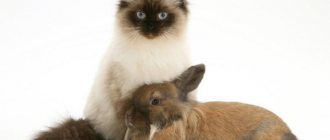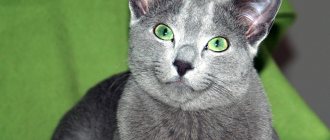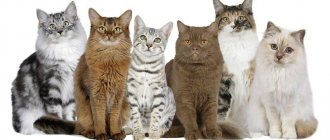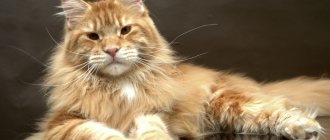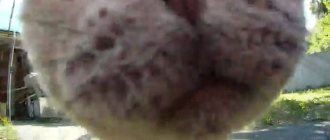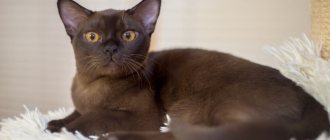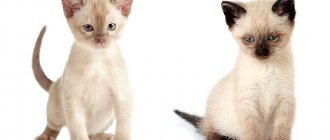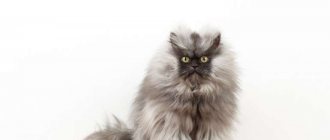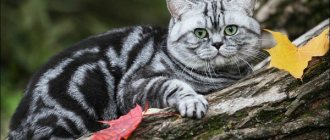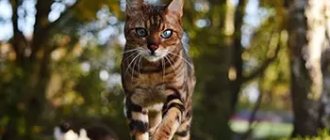Mixed cat, what does it mean?
Metis is not a cat breed. Such animals appear in a parent couple, where one is a representative of an elite breed, and the second is outbred. Another option is possible - when both parents are elite, but belong to different breeds. Crossing between them is allowed, and the litter acquires the qualities of the parent pair and is able to continue the race.
There is another concept - a cat hybrid. This means that individuals from different branches of the biological tree participated in the crossing. For example, a caracal from the Moscow Zoo mated with an ordinary cat, which subsequently gave birth to a healthy large kitten.
This event became a sensation in world felinology and forced a new look at the process of breeding hybrid cats. Thus, the Chausie breed appeared - a hybrid of the wild jungle cat Felis Chaus and the Abyssinian cat, and the Savannah - a mestizo cat bred by mating an African serval and a bengal.
Interesting facts about the Siamese cat
- The color of their coat is determined not only by heredity. This breed has a special modifier gene that prevents the development of pigment in the fur, which leads to albinism. Siamese are considered one of the oldest cat breeds in the world. Legends say that in ancient times the first Siamese cats were tasked with guarding the royal cup. They looked at him with such intensity that their eyes crossed. For added security, the cats wrapped their tails around the cup, causing them to become permanently bent. Siamese cats have appeared in many Hollywood films.
Overall, this is the most affectionate cat breed you will find. She is very smart, obedient and friendly, and also loves and values human communication so much that she is even called a cat-dog.
Advantages and disadvantages of mestizo
According to official data, there are 250 registered cat breeds. The total number of cats living throughout the globe is about half a billion. In addition to officially recognized breeds, there are also stray animals that are not included in the statistics. Random mating results in a huge population of mestizos. Whether this is good or bad is difficult to say, but we have identified several advantages and disadvantages of being mestizos.
Let's start with the pros:
- In the first generation, mixed-breed kittens receive the best characteristics of the parent pair, but later, unfortunately, they lose them.
- Mixed breeds are often healthy, but if one or both parents have an altered genotype, the kittens are more likely to be born sick.
- By purposefully crossing several breeds, it is possible to obtain an animal with a certain set of external qualities.
- The character also determines the genotype of the parental pair. A pampered Persian cat and a calm mongrel cat will not produce aggressive kittens.
As for the disadvantages, there are few of them - keeping a mestizo in the house is neither prestigious nor profitable.
Half-breeds do not have the right to participate in exhibitions, do not have a pedigree, are not allowed to crossbreed with elite animals, and there is no queue of people who want to get a purebred pet. However, cat lovers in most cases do not pay attention to such nuances and happily take outbred animals from the shelter.
Breeding
If you decide to start breeding a Siamese cat, the first step is to find a healthy male. Of course, the best way to do this is to contact the owner of a nursery near where you live. A Siamese cat owner with a good pedigree will be happy to help you in this matter, as he knows how important it is to keep the blood lines pure and reduce the risk of any hereditary problems.
When choosing a breeding cat for your Siamese breed, consider the following factors:
- Is this the first time your female will be mating? If the answer to this question is yes, then you should think about having an experienced male. Have you had all the necessary tests? Before you take your cat for mating, you should arrange a visit to the veterinarian to confirm the absence of hereditary and viral diseases. What are you going to do with the kittens? When choosing a breeding cat, you need to make sure that you can sell the kittens in the future.
Pregnancy in Siamese cats is slightly shorter than other breeds - 58-65 days. On average, a Siamese cat gives birth to 4 to 6 kittens. The colors of kittens can be predicted in advance by knowing the recessive and dominant genes for coat colors in both partners.
Siamese catteries in Russia
The Siamese breed is one of the most numerous, so finding a nursery is not difficult at all:
Metis with British
The British cat is an indigenous breed with an ancient history of development, which begins in the days of the Roman legionnaires. These animals are endowed with refined manners, prefer solitude, do not like noisy companies and too active games. The most common crosses of British cats are with ordinary cats, with Toygers and with Siamese.
A mix of a British cat and a regular cat
Outbred cats have an amazing ability to quickly adapt to their environment. These animals are independent, unpretentious, endowed with excellent hunting skills that allow them not to die of hunger, which cannot be said about most purebred domestic cats.
It is worth noting that street cats do not strive for privacy; they are sociable and do not mind contact with people if they behave kindly. Animals that are brought into the home at an early age are socialized no worse than purebred cats.
Mixed breeds of a British cat and a regular one are most common. Sometimes at first glance it is even difficult to distinguish who is who. Half-breeds have the same massive bone structure and broad chest, but are slightly smaller in size. Developed cheeks make the muzzle round.
Coat colors are varied. The British are characterized by about 200 colors, so the color options for mixed breeds are unlimited. There are individuals with a color-point mask like the Siamese or spectacular silver chinchilla ticking.
The Métis partly adopt the British desire for privacy. Such animals are more eager to be the center of attention; they are quite sociable and responsive.
Interesting. At an early age, half-breeds exhibit to a greater extent the manners of mongrel animals, and in adulthood they show prudence and sedateness - qualities inherent in the British breed.
Toyger/British mix
Mixed Toyger + British cat is an animal with a clear striped pattern on its fur. The Toyger breed was developed relatively recently and received admission to the exhibition career in 2007. These cats are characterized by the only so-called brindle color.
Attitude towards children
By nature, Thai cats are sociable and socially adapted to living in a family with other animals and small children. They, unlike Siamese, will find an approach to all family members; when with children, they will not let out their claws even in a game of chance, and will patiently endure squeezing and annoying caresses.
In addition, Thais are a “talkative” breed of cats: when their owner addresses them, they make funny sounds in response, maintaining a conversation. Sometimes they “chat” incessantly, so those who like silence in the house are better off getting a more phlegmatic breed.
Unlike Thais, Siamese are individuals who become attached to one owner; they are jealous, and this negative character trait sometimes extends to children. If a Siamese is given less attention than children, he will harbor resentment and will not make contact with younger family members.
Both Siamese and Thai breeds are recommended for those who are able to spend a lot of time with their pets.
Maine Coon mixes
The Maine Coon is a large-sized native cat breed. The animals are distinguished by their massive build, strong bones, angular contoured muzzle, and large ears with tufts. Colors can be any: cinnamon, lilac, chocolate and fawn, solid.
The coat is thick, water-repellent, and the undercoat is soft. The neck is decorated with a frill. The tail is long, wide at the base, tapering to the tip, covered with long hair. The eyes are oval, expressive, the color of the iris matches the color of the coat.
Breeding Maine Coon mestizos is officially prohibited, but in reality this issue is not controlled. Amateur breeders often breed Maine Coons with other cat breeds. Half-breeds are much cheaper, which increases the demand for them.
In specialized nurseries, cull cats are not sold for breeding, but they can be purchased as a pet. Such animals must be castrated or sterilized.
It is also important to remember that a purebred Maine Coon and a mixed breed are completely different animals. A half-breed will never meet the breed standard. The appearance of such cats is very diverse and depends on the genotype of the parents.
Purebred Maine Coons are endowed with the following qualities:
- goodwill;
- agreeableness;
- sociability;
- devotion;
- prudence.
When crossed with a regular cat, these traits change or disappear completely.
As for external qualities, purebreds must have tufted ears, an elongated muzzle, massive paws, and a long fluffy tail. Three-month-old kittens should weigh at least 2.5 kg (the cubs of an ordinary cat at this age weigh no more than 1 kg). The body length of adult males is approximately 1 m and weight is 11 kg.
As for attempts to crossbreed the Maine Coon with other breeds, they all failed. The purpose of such experiments was the desire to add some qualities from other breeds to Maine Coons. For example, to produce a big cat of an unusual color, a female Maine Coon was bred with a male Siamese breed. However, the experiment was unsuccessful - kittens of different sizes were born in the litter.
When mated with Persians, the result was large kittens with fluffy red fur without the slightest hint of resemblance to Maine Coons. An attempt to crossbreed with a Bengal to increase body size also failed.
Maine Coon and Siberian kittens are similar in appearance to purebreds, but are of medium size. Such babies are often passed off as noble, but they are sold at a discount and without a pedigree.
A mixed breed of a Maine Coon and a domestic cat was obtained completely by accident. The baby retained the color of his coat, but lost a number of positive character traits.
Maine Coons are also crossed with Britons, Neva Masquerade and other breeds of cats, producing litters with fur of different lengths.
Description of the Siamese breed
Let's look at the appearance and character of Siamese according to the breed standard.
Standard
Siamese cats are well balanced, boasting an athletic, flexible body and elegant, slender legs.
The breed standard for the modern Siamese cat assumes:
- Body: Elongated, tubular and muscular. A typical Siamese cat has a total height of 20-25 cm and a body length of 29-36 cm, with a body weight of 4-5 kg. Head: Straight profile with a strong chin and a pleasant, even bite. The head forms a perfect triangle from the tip of the nose to each tip of the ear. The neck is long. The eyes are almond-shaped, bright blue, and the ears are large, wide, located closer to the head. Limbs: The cat's hind legs are longer than her front legs, which adds to her athletic and graceful appearance. The paws are oval shaped and small. Thin tail. Coat: Short, shiny, fine coat without undercoat that lies close to the body.
Today, there are over 20 varieties of Siamese cat colors all over the world, and the most famous of them are:
- Seal point (brown or cream), with a cream-colored body and dark brown pigments on the nose and paws. It is believed that this was the original color of the breed when it was first exported from Siam (Thailand). Blue Point (blue) - the body is snow-white with a bluish tint, as well as a gray nose and paws. The Red Point is a white body with red (apricot) pigments on the nose and paws. The Caramel Point (light cream) is considered a hybrid due to a complex breeding process, with very light and pink pigments on the nose and paws. Chocolate point (black). The body is cream or milky in color, and the pigments on the points can range from chocolate to black. Cinnamon point (ivory). The body is ivory-colored, like a Chocolate Point, but the markings on the nose and paws are pinkish-brown.
Photos of colors
Mixed bengal cat
The Bengal cat is a cross between a domestic cat and an Asian leopard. Mating Bengals with other breeds is prohibited by all felinological organizations. There are no recognized crossbreeds of this breed, but this does not prevent unscrupulous breeders from crossing Bengals with other breeds or ordinary cats. As a result, mestizos with a variety of colors appear. The second generation completely loses the characteristics of its parents.
Recently, long-haired Bengals have become especially popular; they retain the characteristics of the breed, but have long hair, a fluffy collar and tail.
If earlier breeders sterilized such animals, now the long-haired variety is valued higher than the traditional Bengal cat.
Which breed is smarter?
The fact that the intellectual abilities of the Thais is higher than that of the Siamese is undeniable. The Thai cat is famous for its natural cheerfulness, curiosity and good learning ability. It is difficult to outwit her and it is useless to hide the things she likes.
A Thai beauty has the intelligence to open a kitchen cabinet door or drawer. She has an excellent memory - she will remember where you hid your favorite toy, wait until you are distracted, and steal the trophy.
Thais are trainable: in this respect they resemble dogs, they are trained to fetch various things. If the cat understands that it is being played with, it will happily bring the owner a ball or a toy mouse. Like a dog, she understands the commands: “sit”, “lie down” and knows how to give a paw.
Although the Siamese, like the Thais, have high intelligence, their poor learning ability is determined by their independent and freedom-loving nature. One should not expect complete obedience from the Siamese breed; rather, the owner will have to adapt to the character of such a pet.
We choose by appearance and character
Every cat is unique. However, experts say that a pet’s character and susceptibility to diseases can be predicted by its external features. Mixed breeds of elite cats inherit the exterior and temperament that are characteristic of a particular breed. When choosing a mestizo, pay attention to the phenotype.
"Marquise" phenotype
Such animals are characterized by the following features: short black hair with white spots, a dense body constitution in males, and graceful in females. The phenotype is most often found in short-haired European breeds. Such animals have a stable and quite predictable character. Cats clearly demonstrate their intentions and achieve what they want with perseverance and affection.
Phenotype "Siberian cat"
This phenotype is characterized by a gray color and striped pattern, long hair and thick undercoat, a loose or dense body, a large head, and an elongated muzzle. Character is independent, self-sufficient. These cats walk on their own, define the role of the owner and make it clear what place they occupy in the house. They accept affection at will or according to their mood; they do not like calf tenderness.
Angora cat phenotype
Representatives of this phenotype are distinguished by long or semi-long hair of light shades, have a dry body, and an elegant head. Despite their independent disposition, cats are immensely loyal to their owner, however, sensing a person’s weakness, they are capable of showing aggression. Animals need constant contact with a person from whom they expect stability.
Phenotype "Persian cat"
These animals have long, silky hair without coarse guard hairs, a round head and flattened nose, and a loose or coarse body constitution. Cats demonstrate an independent character, consider themselves the main decoration of the house, and are often capricious. Mixed breeds are often cut like a lion, which makes it easier to care for their long hair.
Phenotype "oriental cat"
These cats are born with short hair, thin and dense bones, developed muscles, and large mobile ears. With an elegant appearance, representatives of this phenotype are quite heavy. Various colors: solid, spotted, striped, tabby, color point. Cats are human-oriented and have a need for regular communication, which is why they received the nickname “cat-dog.” Animals are very energetic, need active games, and try to establish their own rules in the house.
Phenotype "Thai cat"
Representatives of the phenotype have semi-long or short hair. Colors: lilac tabby point, blue point, seal point, lilac point. The color of the iris is exclusively blue. The constitution is dense, but not rough. The character is balanced, calm, non-conflict. The behavior pattern resembles that of a dog. Cats sense their owner's mood swings and are very persistent in achieving goals. They achieve their goals with persistence and affection.
"British" phenotype
This phenotype is characterized by dense and short fur, a round head, erect ears, a rough constitution, and a thick tail with stripes. Common colors are tabby and blue-gray. The character of these animals is independent and stubborn. When achieving what they want, they often show aggression; they do not like to sit on their owner’s lap; they allow themselves to be petted if they are in the mood, otherwise it is better not to approach.
How to choose the right kitten
In order not to make a mistake when choosing a pet, it is not enough to listen only to your inner instinct. Experts advise following the basic rules:
Ask the breeder about all the offspring to determine whether the kittens are suitable: where they grew up, what their character is, whether they were examined by a veterinarian, whether the kittens were picked up after two weeks of age. Have any preventive treatments and vaccinations been carried out? First look at mom. If the kittens are from a nursery, then you should find out as much as possible about the parents. You should not take obstinate representatives who hiss and scratch.
A healthy animal can be identified by the following signs:
- clear eyes without discharge; clean area under the tail; shine of wool; absence of bloating - the first sign of helminthiasis; energy and curiosity; communication with brothers; fearlessness.
Any kitten - purebred, mestizo or mongrel - can become the best friend and companion. He will reciprocate the sincere love and care of the owner. You should not chase expensive, fashionable and purebred cats; it is better to bring into your home a faithful and devoted companion who will not leave you in difficult times and will brighten up the melancholy of gray everyday life.
Nutritional Features
The diet of mestizos is no different from the diet of purebred cats. Considering that felines are obligate animals, the main ingredient in their menu should be meat. In second place are animal fats, in third place are carbohydrates in minimal quantities.
Cats can be fed natural foods:
- rabbit or lamb meat;
- chicken;
- turkey;
- veal;
- chicken giblets;
- sea fish;
- greens;
- fresh vegetables;
- eggs;
- fermented milk products.
You should not give salted, fried, spicy, sweet foods, whole milk, river bony fish, tubular bones. Forbidden delicacies cause excess weight gain, metabolic disorders, and failure of the endocrine, cardiovascular, and urinary systems. Buy treats at veterinary pharmacies or pet stores.
Meals are selected individually. Energy value and nutrient requirements depend on:
- physiological state of the cat (pregnancy, castrated and sterilized animals);
- body weight, constitution;
- health conditions;
- age;
- conditions of detention;
- activity level.
Caring for Mestizos
Recommendations for caring for half-breeds are the same as for purebred cats:
- Long-haired animals need to be combed daily, especially carefully during seasonal shedding. Short-haired cats are combed 2-3 times a week using a furminator, comb, or stiff brush. Persians should not be scratched with a slicker brush, which will damage the delicate hairs.
- Shampoos and conditioners for long-haired cats are used for bathing. Considering the dislike of cats for bathing, with the exception of Maine Coons, this should be done in case of emergency. Cats are clean creatures and are able to keep their coats clean on their own.
- The eyes and ears are examined once a week and cleaned with special lotions or clean water. Persians, like mixed breeds, collect discharge in the inner corners of their eyes that must be removed daily to prevent the risk of developing a bacterial infection.
- Animals should have special rodents freely available to remove plaque.
- A nail clipper is used to trim claws. The procedure is performed carefully, trying not to touch the blood vessels.
It is important to keep the tray clean. The filler can be anything: wood, clay, clumping, silica gel. Some cats eat silica gel granules for some unknown reason. If you notice that your pet is partial to this filler, change it to another one. It is advisable to change the wood one every two days or daily.
Breed card
| Characteristics of a cat | Notes | |
| General information | An ancient cat breed known for its pointing color, playfulness and ringing voice. Extroverts by nature | Modern Siamese are the result of restoring the standard of an ancient breed. And those yard cats, which in Russia are usually mistaken for Siamese, are representatives of the Thai breed |
| Character | Siamese require their owner's attention constantly. They have an affectionate nature and are quick-witted, but can be stubborn | Purchase various toys in advance so that your pet always has something to occupy himself with. |
The best solution would be to purchase a gaming complex for cats
They are incredibly clean and don't shed much, so caring for them is not particularly difficult.
Wool
Even though Siamese cats have short hair, they need to be brushed weekly. Many fans of this breed recommend small rubber brushes. You need to comb in the direction of hair growth.
Most Siamese cats are very clean and clean themselves well, so you can bathe them no more than 2 times a year. However, when they are very dirty or have gotten into something sticky, they may need a little help.
Advice! Place a rubber mat in the sink or bathtub to prevent your cat from slipping.
Nutrition
In addition to basic veterinary care such as vaccination compliance and regular checkups, proper nutrition is important. Providing a proper diet can help prevent health problems in your pet later in life.
Advice! Don't forget to change the water and wash the bowls daily!
There are two options for feeding your pet: natural food and industrial food.
Natural nutrition
The basis of nutrition is animal proteins:
- Lean meats (chicken, rabbit, lean beef and turkey). Sea fish and seafood (tuna, cod, shrimp) - as a source of healthy fats and taurine. Eggs (preferably quail) – no more than once a week. Beef liver and offal - tripe, udder, lips, chicken necks.
Carbohydrates and fats
:
- Fermented milk products - cottage cheese, ryazhenka kefir, yogurt without additives. Vegetables and greens - zucchini, carrots, spinach, pumpkin, broccoli, peas, beets. Porridge – buckwheat, millet, oatmeal, rice. Linseed oil.
Vitamins – additional vitamin complexes are required for natural nutrition. Main additives: taurine, tetravit, calcium and yeast as a source of B vitamins.
Important! Red meat and liver can darken light fur, so you should not make such foods the main food for show cats.
Industrial feed
The basic rule is not to feed your pet economy-class food. The ideal option would be brands from the super-premium and holistic categories. We have previously compiled ratings for dry and wet cat food.
Recommended brands:
Orijien Fit & Trim. Acana Light & Breed. Go Natural. Eukanuba Sterilized. Bosch Sanabelle. Royal Canin “Sterilized 37”.
Sometimes cats are allergic to grains, cow's milk and poultry. In such cases, it is necessary to switch to grain-free lines such as Natural & Delicious, which are free of rice, corn and chicken.
Adult pets with certain diseases (diabetes, urolithiasis, renal failure and heart pathologies) are transferred to specialized veterinary nutrition. A good line of medicinal foods is represented by the Hill's Prescription Diet brand.
Vitamin-mineral complexes are not needed, because manufacturers necessarily include all the compounds necessary for the body in the feed.
Caring for ears, eyes, teeth and claws
- If possible, you should brush your cat's teeth 2 times a week. We revealed all the nuances of this simple procedure in this article. The almond shape of the eyes allows pus and tear fluid to accumulate in the corners, so be sure to wipe your eyes with a damp cotton pad as needed. Ears should be wiped with a barely damp cotton pad once a week. If you notice black spots, crusts and an unpleasant odor, take your pet to the doctor. The most common cause of such symptoms is ear mites, which are easily eliminated in the initial stages. If left untreated, it can lead to hearing loss.
A visit to the veterinarian every year is mandatory for keeping a Siamese cat. Examinations provide an opportunity to early detect health problems, including those that may change your cat's care needs. For example, viral diseases, eating disorders, heart and kidney problems.
The frequency of visits to the veterinarian depends on the age of the pet:
- kitten 1-4 months – monthly visits; 4 months to 7 years – 1-2 times a year; 7-10 years – twice a year; over 10 years old - visit every 3 months or more often, as age-related health problems only increase.
Walking your pet
Siamese cats are ideal pets for both apartments and country houses. They are perfectly adapted to travel and trips, because the main thing for these creatures is the presence of their beloved owner nearby. Cats are good travel companions when they are happy. Your job is to figure out how to make their journey comfortable. Bring your favorite bed, litter box, toys, food and litter box.
They can also be easily trained to walk outside in a harness or in a walking carrier.
Diseases, their prevention and treatment
Mixed-breed cats are generally healthy animals; their susceptibility to diseases depends on their phenotype:
- The “marquise” phenotype has excellent health, but if there is a malnutrition, urolithiasis develops.
- Representatives of the “Siberian cat” phenotype often experience digestive difficulties and are prone to rapid weight gain, diabetes and urolithiasis.
- Angoras have good health, but some individuals have breathing problems.
- In the “Persian” phenotype, diseases of the upper respiratory tract and genitourinary system are observed.
- Representatives of the “oriental” phenotype rarely get sick, but sometimes they are diagnosed with gastrointestinal diseases.
- “Thais” have good health, but some individuals are predisposed to urolithiasis and infectious diseases.
- “The British” are prone to chronic kidney disease, obesity, and suffer from endocrine system disruption and chronic pancreatitis.
Treatment is prescribed exclusively by a veterinarian after a series of diagnostic and laboratory tests.
Prevention of infectious diseases involves timely vaccination, which must be carried out even if your pet does not go for walks in the yard. We bring viruses and bacteria home on the soles of our shoes; mating with animals without a veterinary passport means an increased risk of contracting a genitourinary infection.
According to the vaccination calendar, pets are vaccinated according to age against the following diseases:
- Rabies is an infectious disease that has no cure. Carried by infected animals and rodents.
- Rhinotracheitis is a herpesvirus infection that affects the respiratory system and eyes. Characterized by an acute course. Carriers are sick cats.
- Calcivirosis is an infectious disease transmitted from other cats. Mortality is more than 80%.
- Peritonitis is a disease caused by coronavirus. The route of infection is airborne. Mortality is more than 90%.
- Panleukopenia or feline distemper. – an acute viral disease transmitted from sick cats. Difficult to treat, leads to death in 90% of cases.
- Chlamydia is an infectious disease characterized by a long course, transmitted by birds and rodents, and affects the genitourinary, visual, respiratory, and digestive systems.
- Microsporia or ringworm is a skin disease transmitted from sick animals, as well as from cats to humans.
- Panleukopenia, chlamydia, calcivirosis, rhinotracheitis - at 8 weeks, revaccination at 10-12 weeks, then annually.
- Rabies - at 12 weeks, revaccination every year.
- Microsporia - at 8 weeks, revaccination after 14 days, then annually.
- Viral peritonitis - at 16 weeks, revaccination after 4 weeks, then every year.
